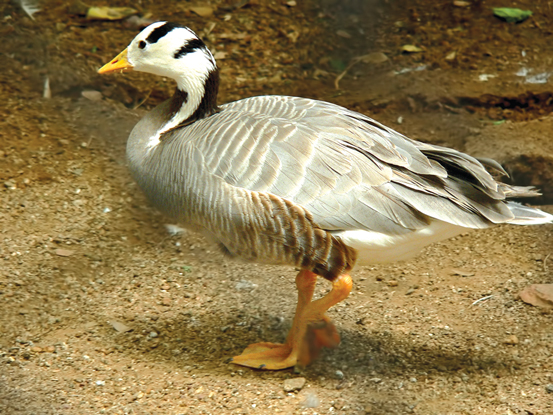Registered with the Registrar of Newspapers for India under R.N.I 53640/91
Vol. XXVII No. 22, March 1-15, 2018
The high-flying geese visit Madras
by Dr. P.J. Sanjeeva Raj (rajsanjeeva@gmail.com)

Bar-headed goose. (Picture courtesy: MNS-Ramanan Padmanabhan.)
How many peaks must a goose fly above
Before it can earn its stripes?
Now, how many days must a goose fly strong
Before it reaches its home?
Yes, how many blizzards must it face
Before it can see the Sun?
The answer my friend is blowin’ in the wind
The answer is blowin’ in the wind…….
(Uttara Mediratta & M.O. Anand
with partial credit to Bob Dylan)
Yes, the Bar-headed goose (Anser indicus) is that iconic goose that flies at a world record height of 21,120 feet (6,437m) inter-continentally, across the Himalayas, from its breeding ground in the Central Asian countries to reach India, its feeding home, from October to March.
Bar-headed geese, known for their high altitude flights, ingeniously employ aerodynamic techniques. At higher altitudes, the density of air and, hence, its pressure and temperature, go down, particularly the oxygen-content to hypoxic conditions, posing great problems for flight. But the most adaptive are the dense blood capillaries of the lung and heart and its RBCs with rich haemoglobin, highly absorptive to scant oxygen. On inter-continental migration, they fly as flocks in inverted ‘V’-shaped formations, constantly communicating by honking. Their choice to fly at night, particularly early in the morning, flying up and down as a flock in waves, not at the top of the mountains, but in their shelter with low wind streams, are all highly adaptive.
It is a bird not often seen in or around Chennai. At the end of last year, Chennai naturalists watched six of them flying low on the link road between Kelambakkam and Kovalam, close to Mahabalipuram. In February, just two of them were noticed at the small irrigation tank in the Keelnathur village, in Tiruvannamalai District. But in December 2000, 58 of these geese were recorded foraging in grain fields on Venadu Island, in the Pulicat Lake. However, its feeding grounds in India are grasslands and grainfields adjacent to lakes all over the country. They are more visible in the extreme south, where you can sight them in Koodankulam and Nanguneri in Tirunelveli District, Point Calimere, and Trichy and Ramnad Districts.
This goose is a little larger than our domestic duck and is white or grey-streaked. The chief identifying marks are the two black bars across its nape and broad stripes along the neck.
During May and June, they breed in large colonies in the high ranges of the mountains in Mongolia, Kazakhstan, Kyrgystan and also in Ladakh. Three to six, occasionally even eight eggs, are laid in flat nests on the ground or on trees.
In May-June, 2005, a wild migrant population of Bar-headed geese in the Qinghai Lake in China, was noticed to be perishing in large numbers. On investigation, they were found to be infected by a virulent strain of the H5N1 virus, the causative agent for the Highly Pathogenic Avian Influenza (HPAI), that can spread to humans also. So, the Bar-headed goose was declared a potential inter-continental threat that could spread the Bird Flu.
Despite their dangerous flying across the Himalaya, the perennial threat from the H5N1 virus spreading virulent bird flu, predation, game hunting and poaching for them in the Asian countries, the International Union for Conservation of Nature (IUCN), in its Red Book, has assigned this Bar-headed goose to the category of “Least Concern”, meaning that its conservation globally is safe and secure.

